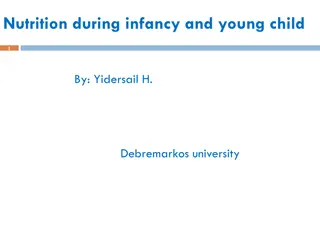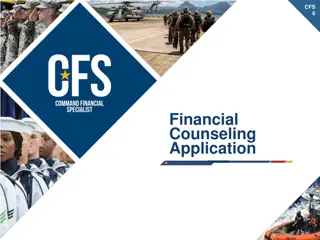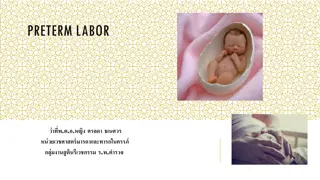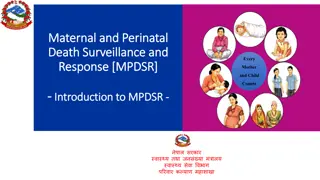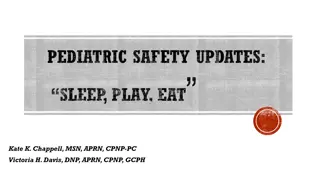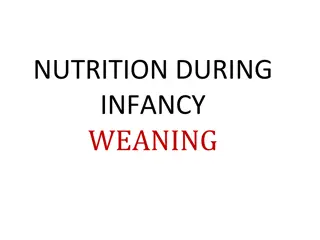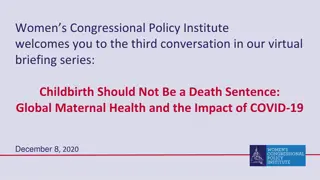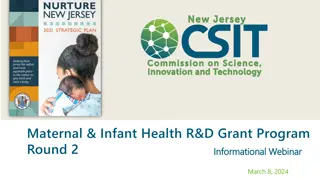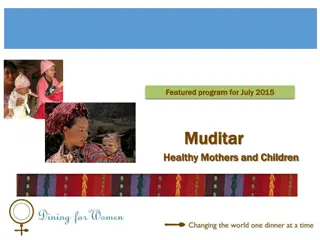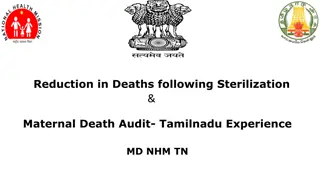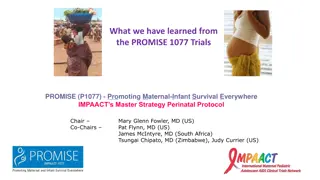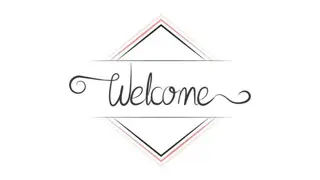Enhancing Maternal and Infant Nutrition through Counseling
Maternal Nutrition Counseling is crucial for supporting pregnant and breastfeeding women, especially adolescents and those at-risk groups, to adopt and maintain positive practices. Skilled Breastfeeding Counseling plays a vital role in empowering women to breastfeed successfully by addressing challenges sensitively and effectively through personalized support and guidance.
Download Presentation

Please find below an Image/Link to download the presentation.
The content on the website is provided AS IS for your information and personal use only. It may not be sold, licensed, or shared on other websites without obtaining consent from the author.If you encounter any issues during the download, it is possible that the publisher has removed the file from their server.
You are allowed to download the files provided on this website for personal or commercial use, subject to the condition that they are used lawfully. All files are the property of their respective owners.
The content on the website is provided AS IS for your information and personal use only. It may not be sold, licensed, or shared on other websites without obtaining consent from the author.
E N D
Presentation Transcript
NATIONAL MATERNAL, INFANT, YOUNG CHILD AND ADOLESCENT NUTRITION OPERATIONAL AND PROGRAMMATIC GUIDELINE COUNSELLING
Counselling Interchangeably used with information & education A process & interaction between counsellors & pregnant women/ mothers Form of interpersonal communication Helps influence individuals to adopt & maintain positive practices People-centred counselling - responds to individual mothers & families needs, preferences & values Maternal Nutrition Counselling An interactive process between a service provider, a woman & her family during which information is exchanged & support is provided Helps women & their families make decisions, take action to improve nutrition Many women do not receive quality nutrition counselling
Maternal Nutrition Counselling Women to be prioritized for more intensive counselling support All pregnant or breastfeeding adolescent girls (<20 years of age) Those with any form of malnutrition (e.g., short stature, underweight, overweight, obesity, anaemia) Women pregnant or breastfeeding for the first time Other at-risk groups; Women with disabilities Chronic diseases (e.g., HIV and tuberculosis) Mental health problems Those affected by the harmful use of drugs or alcohol
Skilled Breastfeeding Counselling Skilled breastfeeding counselling; A key interventions to improve breastfeeding rates Aims to empower women to breastfeed Respects women's personal situations & wishes Sensitive & effective counselling assists mothers overcome challenges
Skilled Breastfeeding Counselling Recommendation for skilled breastfeeding counselling Provided to all pregnant women & mothers with young children Provided in antenatal & postnatal period, & up to 24 months or longer Provided at least six times, & additionally as needed Provided through face-to-face counselling Provided as a continuum of care Anticipate & address important challenges & contexts for breastfeeding Establish skills, competencies & confidence among mothers
Target audiences for counselling Women planning to conceive Pregnant adolescents & women Postpartum adolescents & women (between birth & at least six months after delivery) Family members targeted as they influence decisions about women s diets, use of essential nutrition services and practices
Counselling modalities Individual Counselling Most effective form of counselling Focus on specific problems & needs of a woman Delivered face to-face Prioritized to women at nutritional risk (e.g., women with underweight or obesity); Time-consuming & challenging to provide the physical space & privacy Remote approaches (i.e., telephone helplines, mobile phones & internet) help where face-to-face counselling capacity or access is limited or absent
Counselling modalities cont. Group counselling Facilitated by HW, CHW or lay person At facility or community level Most effective when group members have similar issues, problems & sociocultural backgrounds Allows interaction with multiple clients Participants share experiences Builds socially supportive relationships Doesn't cater to specific needs Doesn t provide an environment to feel comfortable or share problems Provided to women at lower risk of nutrition challenges
Timing, frequency & duration Begins three months before planning a pregnancy, as early as possible in pregnancy The minimum of six breastfeeding counselling contacts are; Before birth (antenatal period) During & immediately after birth (perinatal up to first 2 3 days after birth) At 1 2 weeks after birth (neonatal period) In the first 3 4 months (early infancy) At 6 months (at the start of complementary feeding) After 6 months (late infancy & early childhood) Additional contacts as necessary Planning to return to school or work When concerns or challenges related to breastfeeding arise When opportunities for breastfeeding counselling occur e.g. child immunization visits, home visits
Timing, frequency & duration of counselling Timing Content Pre conception At least three months before Healthy diets, IFA supplementation planning a pregnancy As early as possible in pregnancy ANC contacts up to the start of the third trimester Towards the end of pregnancy Pregnancy Dietary intake, physical activity, adherence to supplementation regimens, hygiene Breastfeeding counselling in preparation for the birth Healthy dietary intake, adherence to dietary supplements to replenish nutrient stores following pregnancy, requirements during attain and maintain a healthy weight Postnatal care contacts in the first six weeks postpartum At least six months following the birth Linked with nutrition & health services for infants children (e.g., contacts, monthly monitoring & promotion, sick child visits & other community nutrition platforms) Lactation meet nutrient breastfeeding, and & young immunization growth
Counselling contacts Counselling contacts are used for: Follow-up on agreed actions Discuss new challenges & actions Identify & refer women to address underlying conditions Referrals to other services (e.g., social protection programs for very low- income households)
Barriers to counselling Inadequate integration into primary health care Sub optimal access to health & community services by women Insufficient knowledge, competencies, motivation or time among HWs & CHWs to provide quality counselling Counselling approaches, materials & messages not adapted to the local setting including the economic context, social norms & sociocultural practices that influence maternal nutrition practices Lack of clear counselling targets Lack of monitoring to measure progress & hold managers, HWs & CHWs to account
Counselling in humanitarian contexts Adolescent girls & women are vulnerable to undernutrition Include, deliver & prioritize counselling in emergencies Start counselling (breastfeeding & maternal nutrition) from the onset of emergency response actions Staff trained to be sensitive to psychosocial issues, nutrition screening & referral to more specialist support Positive feedback & emotional support to support the mothers confidence & self-efficacy in breastfeeding
Counselling in humanitarian contexts More specialist capacity to counsel mothers with heightened needs Stressed or traumatized mothers Malnourished infants & mothers Low-birth-weight infants Infants with disability & feeding difficulties Consider other options where movement restricted or interrupts routine services
Counselling Dos and Donts Counselling should anticipate & address important challenges that may affect a woman s capacity to adopt positive practices e.g. her age, experience, sociocultural & economic context Focus on small doable actions that a woman can take Focus on small doable actions that a woman s family members can take Focus on concrete actions that other individuals (e.g., husbands/ partners, grandmothers, etc.) can take to support the woman s actions Do not try to change too many practices at once
Peer to peer support groups Mother to mother support group (MtMSG) A meeting where pregnant women & mothers with young children, and people with similar interests, come together in a safe place to exchange ideas, share experiences, give & receive information, offer & receive support in IYCF and women s health Characteristics of MtMSGs 8-15 people per group Audience: pregnant & lactating women, caretakers or parents of children under 5 yrs Hold regular meetings Grandmothers, mother-in laws, partners/ spouses invited to attend sessions quarterly Model optimal breastfeeding practices
MtMSGs Formation of MtMSGs A support group is formed when people come together with a common interest or life experience May be informal or formal Provides: Safe environment Sense of respect Sharing information Availability of practical help Sharing responsibility Acceptance Learning together and from each other Emotional connection Structure of MtMSG Source: UNICEF MoH & Partners 2022
Implementation of MtMSGs Implementers should be trained in breastfeeding, young child feeding, counseling skills & dynamics of support groups Each district should have a lead mother trained on 12 IYCF key messages The training done by counselors Lead mother responsible for 8 - 15 members Each group has one session / week & Sessions on key messages to be completed in 12 weeks within 3 months & make follow up IYCF CNVs supports lead mothers at community level, staff at facility & community level
Implementation of MtMSGs cont Possible groups for mobilization MTMSGs; Women s groups Religious groups Married adolescent groups Breastfeeding groups Groups for preventing mother-to-child transmission (PMTCT) of HIV Groups for people living with HIV/AIDS (PLHA)
Implementation of MtMSGs cont Where, when, & how interactions between mothers happen One-on-one Groups Informally Formally Anytime Anywhere MtMSGs occurs in a variety of settings including; Chance contacts with mothers in the community Groups of pregnant women & breastfeeding mothers Telephone counseling, hospital, & home visits Interactive presentations at service club meetings, schools, universities
Sustainability of MtMSGs activities Challenges to sustainability Shortage & turn-over of volunteers Financial constraints How to address challenges; Focus on one or two activities Match tasks to available time Provide incentives e.g. stipends, food, free medical services, a graduation ceremony, training certificate, special clothing & other articles to distinguish the volunteers Initiate IGAs, e.g sale of tee-shirts, posters, & educational materials Support from donors for training & program grants & in-kind contribution of goods (such as NFIs & equipment) & services Network & collaborate with government agencies & NGOs to facilitate two-way referrals, shared training, & technical assistance opportunities Establish a solid & consistent support structure, with committed individuals to support growth
Care Groups (CG) A community-based strategy for promoting behavior change A group of 10 15 community-based volunteers Meet regularly with project staff for training & supportive supervision Multiplying effect & equitably reach every beneficiary household through neighbor to neighbor peer support using interpersonal behavior change activities Care Group Volunteers (CGVs) Provide greater peer support to one another Develop stronger commitments to health activities Find creative solutions by working as a group vs volunteers working independently CGs provides structure for a community health information system that reports on new pregnancies, births & deaths detected during home visits
Care Group Structure Source: A training Manual for Program Design and Implementation- 2014
Care group Implementation Care group criteria -critical to the effectiveness of the CG approach Formative research to strengthen care groups Organize beneficiaries into Neighbor Group (NG) & CGs, community list or gathering Define responsibilities for CGVs, Promoters, Supervisors & Maternal and Child Health & Nutrition Coordinators Volunteers motivation & incentives
Care group Implementation What happens in a care group meeting, neighbor group & home visit Home Visit: the audience, timing and content The meeting schedules Supportive supervision: checklist & supervisory work plans Quality improvement & verification checklist (QIVCS) & giving feedback Calculate scores & using data from quality improvement & verification checklist (QIVC) CG monitoring information system: Introduction to registers, promoter, supervisor & coordinator reports Plan for sustainability
Father to Father Support Group (FTFSG) Men play an important role in MIYCN Comprise of ; Partners of pregnant women Male caregivers of children under 2 years Groups hold regular meetings Learn about and discuss; The importance of MIYCN practices The critical role men play in child care The group size varies from 3 to 12 Facilitated by an experienced & trained facilitator who listens and guides the discussion. The facilitator and the participants decide the length and frequency of the meetings
MIYCAN Training Equip HWs & CHWs with the knowledge, skills & competencies to provide quality nutrition services Supervisors & managers to attend training, to familiarize with content & skills Supportive supervision, mentorship & on job training Newly trained HWs supervised within 6 weeks to 2 months after training Post-training follow-up determination need for reinforcement of specific participant s knowledge, skills & competencies through additional or refresher training, ongoing supportive supervision, mentorship, OJT, continuous nutrition education Trained facilitators, supervisors should observe & evaluate participants at their workplace
MIYCAN Training Cont.. Objectives of supportive supervision, mentorship & OJT Supportive supervision, OJT & mentorship used to: Monitor & promote quality standardized services Assess performance in relation to quantity (i.e., reach- coverage, volume, service utilization) Use knowledge & skills to counsel mothers/caregivers with accurate information & facilitate group work Ability to use recording & reporting tools Identify difficulties in knowledge & skills learned & support to resolve the issues Share best practices, experiences & lessons learnt
MIYCAN Training Cont.. Timing for Supportive Supervision, mentorship and on job training Supportive supervision/mentorship part of routine monitoring activities Initial visit to fit into a schedule of ongoing supportive supervision to promote integration If no system of ongoing supportive supervision or mentorship All newly trained on MIYCAN should receive a minimum of 2-3 visits Participate in regular meetings to share experiences, mutual support & on- going or refresher training Support supervision conducted by trained facilitator, supervisor, or project manager
MIYCAN Training Cont.. Where to hold supportive supervision, mentorship and on job training Provide on-the-job support or mentorship A counselling with a mother/father/caregiver & child in a community or home During group education (action-oriented groups) During support group facilitation
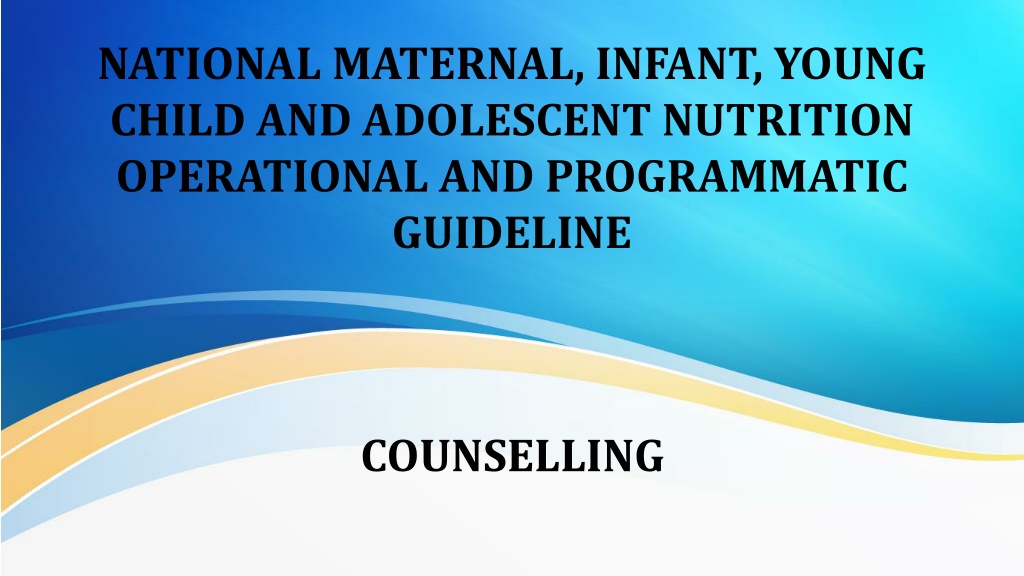
 undefined
undefined





